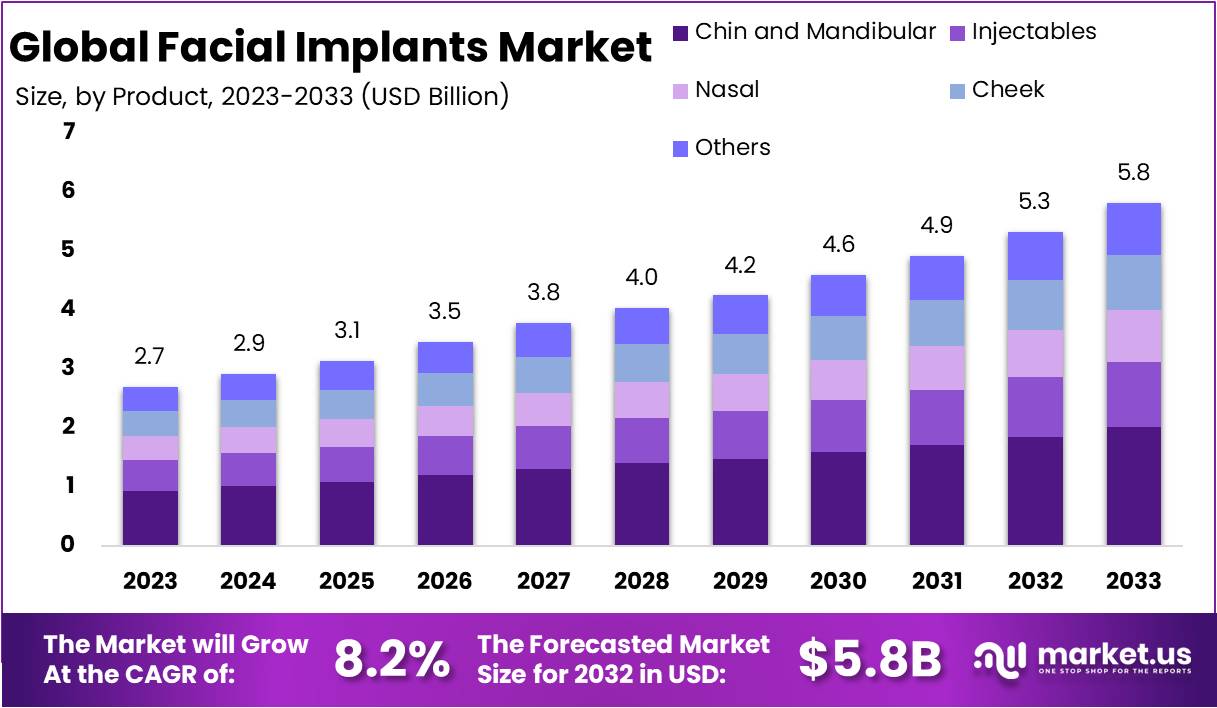Table of Contents
Introduction
The Global Facial Implants Market is projected to grow significantly, reaching approximately USD 5.8 billion by 2033 from USD 2.7 billion in 2023. This expansion is driven by a Compound Annual Growth Rate (CAGR) of 8.2% between 2024 and 2033. Key growth factors include rising demand for aesthetic procedures, advancements in medical technology, and increasing reconstructive surgeries. The market is segmented by product type, material, procedure, and region, with major contributions from developed nations and emerging medical tourism destinations.
The increasing interest in cosmetic surgeries is a major driver. Many individuals opt for chin, cheek, nasal, and injectable implants to enhance facial symmetry and aesthetics. The influence of social media and beauty trends has fueled demand, particularly among younger populations. In parallel, the rise in reconstructive surgeries for trauma victims and patients with congenital defects further boosts market growth. Government healthcare policies and improved insurance coverage have enhanced accessibility to these procedures, increasing their adoption.
Technological innovations have significantly improved the safety and effectiveness of facial implants. 3D printing allows for customized implants, enhancing precision and reducing complications. The use of biocompatible materials like porous polyethylene, silicone, and advanced ceramics ensures better integration with the body. Minimally invasive techniques have also gained traction, leading to shorter recovery times and higher patient satisfaction. These advancements are expected to drive further market expansion in the coming years.
The global aging population is another crucial factor. With age, individuals experience loss of facial volume and elasticity, increasing the demand for facial implants to restore structure. Developed nations, where the aging population is rising steadily, contribute significantly to market growth. Additionally, the medical tourism sector is flourishing, with countries like South Korea, Thailand, and Turkey attracting international patients. Cost-effective treatments, experienced surgeons, and government support for medical tourism ensure steady market expansion.
Awareness and acceptance of plastic and reconstructive surgeries have improved, reducing stigma. Educational campaigns by health organizations and surgeons emphasize the benefits and safety of these procedures. As healthcare infrastructure improves and innovative technologies emerge, the facial implants market is set to witness sustained growth. The combined impact of increasing aesthetic awareness, reconstructive needs, and global healthcare advancements positions the market for strong expansion through 2033.

Key Takeaways
- Market Expansion: The facial implants market is projected to reach USD 5.8 billion by 2033, growing at a CAGR of 8.2% from 2024 to 2033.
- Leading Segment: In 2023, chin and mandibular implants held over 34.7% market share, reflecting strong consumer demand for enhanced jawline aesthetics.
- Material Dominance: Polymers led with a 39% market share in 2023, valued for their lightweight properties, durability, and versatility in facial implant applications.
- Popular Procedures: Eyelid surgery accounted for 41% market share in 2023, highlighting a preference for subtle yet effective facial enhancements.
- Market Drivers: Growth is fueled by beauty standards, material innovations, and rising demand from aging populations seeking facial rejuvenation.
- Key Challenges: High costs, complication risks, limited insurance coverage, and societal stigmas hinder widespread market adoption.
- Growth Opportunities: Expansion into emerging markets, increasing customization trends, and 3D printing advancements drive innovation and precision in implant production.
- Industry Trends: The rise of non-invasive alternatives, bioabsorbable implants, and male aesthetic procedures influences market evolution.
- Regional Leadership: North America led with a 38% market share in 2023, driven by aesthetic consciousness, advanced technology, and higher disposable income.
- Global Expansion: Europe and Asia-Pacific are experiencing rapid growth, propelled by shifting beauty preferences and greater healthcare awareness.
Emerging Trends
- Non-Surgical Alternatives: More people now prefer non-invasive facial rejuvenation. Instead of surgery, they opt for treatments with minimal downtime. Popular methods include surgical threads, Botox, and microneedling. These techniques help lift and tighten the skin while reducing wrinkles. They also provide faster recovery and fewer complications. Patients looking for subtle enhancements choose these options over traditional implants. The demand for non-surgical solutions is rising as technology improves. Many clinics now offer these procedures as effective alternatives to surgery.
- Regenerative Treatments: New injectable treatments are changing facial aesthetics. One innovation is Renuva, which stimulates natural fat regeneration. Unlike synthetic fillers, it encourages the body to produce its own volume. This makes the results look more natural and last longer. Regenerative treatments reduce the need for repeated injections. They also lower the risk of complications. Patients seeking long-term facial rejuvenation increasingly choose these options. Experts believe that regenerative medicine will play a key role in the future of facial implants.
- Customized Implants: Technology is making facial implants more personalized. 3D printing and digital modeling allow doctors to design implants that fit each patient perfectly. These customized implants enhance precision and improve patient satisfaction. They also reduce complications, as they match the patient’s facial structure more accurately. Traditional implants come in standard sizes, which may not suit everyone. Personalized implants provide better aesthetic results and faster healing. This trend is gaining popularity among both surgeons and patients.
- Integration of Artificial Intelligence (AI): AI is transforming aesthetic medicine. It helps doctors plan procedures with greater accuracy. AI-powered imaging tools analyze facial features and predict treatment outcomes. This allows for more precise adjustments before surgery. AI also improves patient consultations by offering realistic previews of results. With better planning, doctors can reduce errors and enhance overall satisfaction. As AI technology evolves, it is expected to become a standard in facial implant procedures.
- Biodegradable Implants: Sustainability is becoming important in facial aesthetics. Biodegradable implants offer a safer alternative to traditional options. Unlike permanent implants, these dissolve over time. This eliminates the need for removal surgeries and lowers the risk of complications. Patients benefit from a more natural healing process. Researchers are developing advanced materials that integrate with the body while maintaining structural integrity. As awareness of sustainable options grows, biodegradable implants are expected to become more common in the industry.
Use Cases
- Chin Augmentation (Genioplasty/Mentoplasty): Chin implants improve the size, shape, and projection of the chin. They help create better facial symmetry and enhance the overall profile. Many people choose chin augmentation to achieve a stronger, well-defined jawline. The demand for these procedures has grown significantly. This increase is due to advancements in materials and techniques, making procedures safer and more effective. A well-proportioned chin enhances facial balance, boosting confidence. Both men and women seek chin augmentation to improve their appearance and correct any natural or age-related deficiencies.
- Cheek Enhancement (Malar Augmentation): Cheek implants restore volume and add definition to the mid-face. They enhance the cheekbones, creating a youthful and lifted appearance. Many people experience facial fat loss with age, leading to a sunken look. Cheek implants provide a long-lasting solution to this problem. They are also popular among younger individuals looking for higher, more sculpted cheekbones. Advances in implant technology have made these procedures more natural-looking and safe. Silicone and other biocompatible materials ensure durability and a seamless fit. Cheek enhancement is a minimally invasive way to achieve a contoured, youthful face.
- Jawline Definition: Mandibular implants create a strong, well-defined jawline. Many individuals opt for this procedure to enhance facial structure and balance. A weak or receding jaw can affect overall facial proportions. Jaw implants add volume and shape, providing a more chiseled look. They are particularly popular among men seeking a more masculine profile. However, women also choose jawline implants for better symmetry and contour. Modern implants blend seamlessly with natural bone, offering long-term results. The demand for jawline enhancement continues to grow due to social media trends and beauty standards. The procedure is now safer, quicker, and more effective than ever.
- Nasal Reconstruction (Rhinoplasty): Nasal implants improve both function and appearance. They help correct nasal asymmetry, enhance projection, and fix structural deficiencies. Many people undergo rhinoplasty for cosmetic reasons, but others need it for medical issues. Conditions like a deviated septum or collapsed nasal bridge can impact breathing. Implants provide a long-lasting solution to these problems. Surgical advancements have made nasal reconstruction more precise and customizable. Patients can choose materials that match their needs, ensuring a natural look and feel. Whether for aesthetic enhancement or medical necessity, nasal implants play a crucial role in facial harmony and overall health.
Conclusion
The facial implants market is set to expand steadily due to rising demand for cosmetic and reconstructive procedures. Advancements in technology, such as 3D printing and AI-driven planning, are making treatments more precise and safer. Increasing awareness and acceptance of aesthetic enhancements are driving market growth, especially among younger individuals and aging populations. Emerging trends like biodegradable implants and regenerative treatments are also shaping the industry. The expansion of medical tourism and improved healthcare infrastructure further support market development. While challenges like high costs and limited insurance coverage remain, innovation and increasing accessibility will continue to fuel growth. The market is expected to witness sustained demand, offering opportunities for further advancements and investment.
Discuss your needs with our analyst
Please share your requirements with more details so our analyst can check if they can solve your problem(s)



